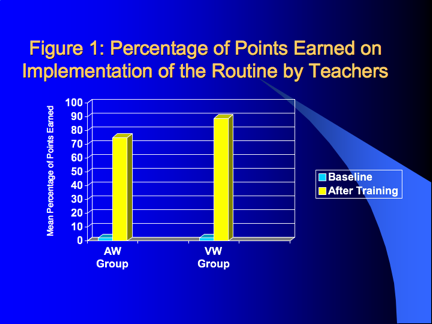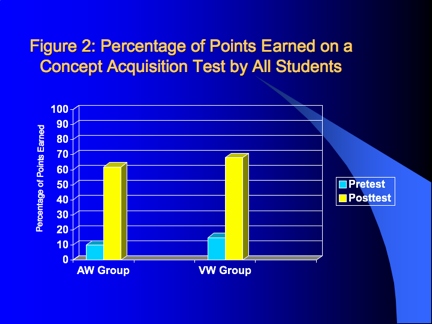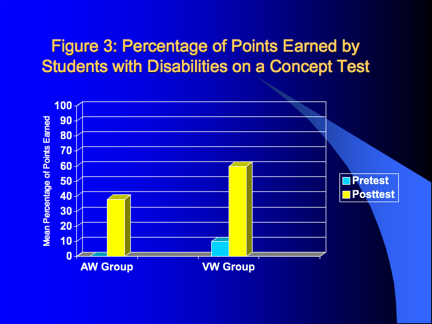Additional information
| Cover | Paperback |
|---|---|
| Dimensions (W) | 8 1/2" |
| Dimensions (H) | 11" |
| Publisher | Edge Enterprises, Inc. |
| Year Printed | 2007 |
| Includes | Manual and CD |
$44.00
| Cover | Paperback |
|---|---|
| Dimensions (W) | 8 1/2" |
| Dimensions (H) | 11" |
| Publisher | Edge Enterprises, Inc. |
| Year Printed | 2007 |
| Includes | Manual and CD |
Overview
The Concept Mastery Routine is used by teachers to teach students about a new concept by relating it to a familiar concept. To test the effects of a CD program for instructing teachers in how to use the Concept Mastery Routine, a study was conducted with 8 general education teachers who taught grades 6 through 8. They were randomly selected into an experimental and a control group. Four teachers worked through this CD program (hereafter referred to as the “virtual workshop” [VW] group) to learn how to use the Concept Mastery Routine. They used the routine in their general education classes with a total of 76 students, six of whom had disabilities. Four teachers (hereafter referred to as the “actual workshop” [AW] group) participated in a live workshop to receive instruction from one of the researchers. These teachers used the routine with a total of 49 students, including five students with LD. The purpose of the study was to determine whether the virtual workshop experienced through the CD program was as effective as the actual live workshop. A multiple-baseline across-teachers design was used to determine the effects of instructing the teachers. A pretest-posttest control-group design was used to determine the effects of the teachers’ instruction on student learning.
Results
The teachers’ implementation of the Concept Mastery Routine was measured before and after the instruction. The results are shown in Figure 1. The baseline scores earned by the two groups were compared using the Kruskal-Wallis One-Way Analyses of Variance by Ranks (KWANOVA). Results indicated no significant differences between the groups’ pretest implementation scores [X2(1, N = 8) = 0.02, p = 0.881]. The posttest scores of the two groups were also compared using the KWANOVA. Again, results indicated no significant differences between the groups’ scores [X2(1, N = 8) = 1.33, p < 0.248].

A Concept Acquisition Test was administered to students over a concept taught before the teachers were instructed and over a concept taught in the last observed lesson of the study. The test was comprised of open-ended items. Thus, students had to know the information and write it on the test, not merely recognize a correct answer in a list of multiple-choice items.
The Concept Acquisition Test was administered at the end of each designated lesson. Results for all the students are shown in Figure 2. Results for the students with disabilities are shown in Figure 3. Dependent t-tests indicated that the posttest aggregated classroom means of students whose teachers participated in the Virtual Workshop were significantly different than their pretest scores [t(7) = 9.93, p = 0.002], as were the means of students whose teachers participated in the Actual Workshop [t(7) = 8.35, p = 0.004].
Analysis of Covariance (ANCOVA) was used to compare the aggregated classroom means of the student groups. Posttest scores served as the dependent variable, and pretest scores served as the covariate. This analysis revealed no significant difference between the posttest scores of students whose teachers participated in the Virtual and Actual Workshops [F (1, 7) = 0.30, p = 0.606].


Conclusions
These results show that the Professional Development CD Program (the virtual workshop) is as effective as live instruction with regard to instructing teachers in how to use the Concept Mastery Routine. Both CD instruction and live instruction produced mastery levels of performance in the teachers and significant differences between their pre-instruction and post-instruction implementation scores. Furthermore, the CD Program appears to produce about the same levels of learning in students. Because the numbers of students with disabilities in each group were small, statistical tests between the groups were not possible. However, the students with disabilities who were taught by the VW teachers earned higher scores than the students with disabilities who were taught by the AW teachers. All students made significant gains from pretest to posttest, regardless of the type of training their teachers experienced.
References
Fisher, J. B., Deshler, D. D., & Schumaker, J. B. (1999). The effects of an interactive multimedia program on teachers’ understanding and implementation of an inclusive practice. Learning Disability Quarterly, 22(2), 127-142.
Schumaker, J. B. (2002). Preparing teachers for academic diversity: Continuation report for SBIR Phase I Grant #R44HD36173. Washington, D.C.: National Institute of Child Health and Human Development, National Institute of Health.
data issue dc

 Professional Development Program for the Question Exploration Routine (Manual...
Professional Development Program for the Question Exploration Routine (Manual...